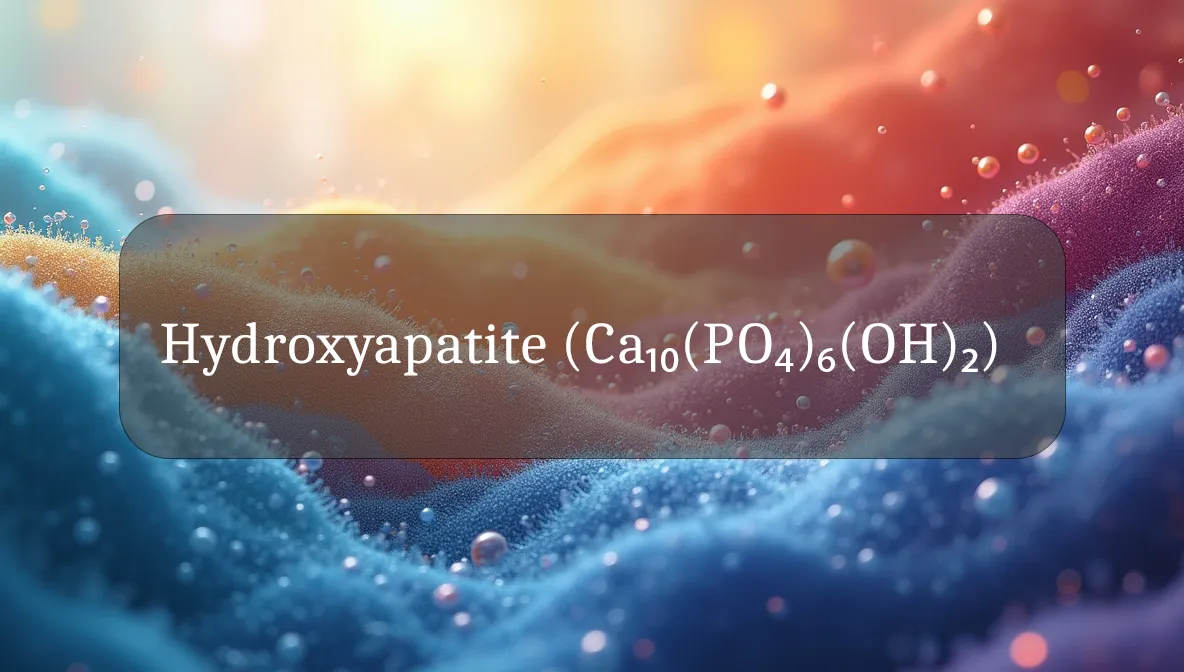Mineral Powerhouse for Bones and Teeth
Hydroxyapatite, a naturally occurring mineral, is the foundation of your bones and teeth, giving them strength and resilience. This guide breaks down everything you need to know about hydroxyapatite, from its role in your body to how you can support its health for a stronger, healthier you.
Chemical Identity and Composition
Hydroxyapatite, with the chemical formula Ca₁₀(PO₄)₆(OH)₂, is a calcium phosphate mineral. It’s the primary inorganic component of bone and tooth enamel, making up about 70% of your bones and 90% of your tooth enamel. Its crystal-like structure, rich in calcium, phosphate, and hydroxyl groups, provides durability and stability to these tissues. Think of it as the sturdy scaffolding that keeps your skeleton and smile intact.
Biological Role and Health Benefits
Hydroxyapatite is your body’s natural building block for:
- Bone Strength: It forms the mineral matrix of bones, giving them rigidity and the ability to withstand physical stress.
- Tooth Enamel Protection: It creates a hard, protective layer on teeth, resisting wear and decay.
- Tissue Repair: Hydroxyapatite supports bone remodeling, helping your body repair micro-fractures and maintain bone density.
- Biocompatibility: Its natural presence in the body makes it ideal for medical uses, like bone grafts or dental implants, as it integrates seamlessly with living tissue.
By maintaining healthy hydroxyapatite levels, you support strong bones, a confident smile, and overall mobility.
Sources (Dietary/Supplemental)
Your body produces hydroxyapatite using calcium and phosphorus from your diet. Key sources include:
- Dietary Sources:
- Calcium-rich foods: Dairy (milk, yogurt, cheese), leafy greens (kale, broccoli), fortified plant milks, and sardines with bones.
- Phosphorus-rich foods: Fish, poultry, eggs, nuts, seeds, and whole grains.
- Vitamin D: Helps absorb calcium (found in fatty fish, egg yolks, fortified foods, or sunlight exposure).
- Magnesium: Supports bone health (found in nuts, seeds, spinach, and beans).
- Supplemental Sources:
- Calcium supplements (e.g., calcium carbonate or citrate) paired with vitamin D.
- Hydroxyapatite supplements, often derived from bovine bone or synthetic sources, used in bone health formulas or dental products like toothpaste.
- Microcrystalline hydroxyapatite (MCHA) supplements, which provide bioavailable calcium and phosphorus.
A balanced diet rich in these nutrients ensures your body has the raw materials to build and maintain hydroxyapatite.
Imbalance Signs
Your body tightly regulates hydroxyapatite, but imbalances in calcium, phosphorus, or related nutrients can cause issues:
- Deficiency Signs (low hydroxyapatite or poor bone health):
- Weak or brittle bones (osteoporosis or osteopenia).
- Frequent fractures or slow healing.
- Tooth decay, enamel erosion, or sensitivity.
- Muscle cramps or fatigue (linked to low calcium).
- Excess Signs (rare, often from over-supplementation):
- Kidney stones or calcium deposits in soft tissues.
- Constipation or nausea from excessive calcium intake.
- High blood phosphorus levels, which can disrupt bone health.
If you notice these symptoms, consult a healthcare provider to check your nutrient levels and bone health.
Supporting Optimal Levels
To keep your hydroxyapatite levels strong and your bones and teeth healthy:
- Eat a Nutrient-Dense Diet: Focus on calcium- and phosphorus-rich foods, like dairy, fish, and greens. Pair with vitamin D sources (e.g., salmon or sunlight) to boost absorption.
- Exercise Regularly: Weight-bearing activities like walking, jogging, or strength training stimulate bone remodeling, helping hydroxyapatite stay robust.
- Avoid Bone Robbers: Limit excessive caffeine, alcohol, and smoking, which can weaken bones by reducing calcium absorption or increasing bone loss.
- Consider Supplements Wisely: If your diet lacks calcium or vitamin D, supplements can help, but avoid megadosing. Hydroxyapatite-based toothpastes can support enamel repair.
- Monitor Bone Health: After age 50, consider bone density scans (DEXA) to track bone strength, especially if you have risk factors like family history or low body weight.
Small, consistent habits like these can keep your hydroxyapatite-powered bones and teeth in top shape.
Safety, Interactions, and Precautions
Hydroxyapatite is naturally safe as a body component, but dietary or supplemental use requires care:
- Safety: Most people get enough calcium and phosphorus from food. Over-supplementing can lead to kidney stones or heart issues, especially without vitamin D or magnesium balance.
- Interactions:
- Calcium supplements may reduce absorption of certain medications (e.g., antibiotics like tetracycline or thyroid meds). Take supplements 2–3 hours apart from meds.
- High phosphorus intake (e.g., from processed foods) can disrupt calcium balance, weakening bones.
- Precautions:
- If you have kidney disease, hypercalcemia, or parathyroid issues, consult a doctor before taking calcium or hydroxyapatite supplements.
- Hydroxyapatite in dental products is safe but won’t replace proper oral hygiene.
- Avoid synthetic hydroxyapatite nanoparticles (used in some medical applications) in unverified supplements, as their long-term safety is unclear.
Fun Fact
Did you know hydroxyapatite is so durable that it’s often preserved in fossils? Paleontologists study ancient bones and teeth because hydroxyapatite’s crystal structure can survive millions of years, giving us clues about dinosaurs and early humans!
Citations
- National Institutes of Health, Office of Dietary Supplements. (2025). Calcium Fact Sheet for Health Professionals.
- Mayo Clinic. (2024). Bone Health: Tips to Keep Your Bones Healthy.
- Cleveland Clinic. (2023). Understanding Osteoporosis and Bone Density.
- World Health Organization. (2022). Nutrition: Calcium and Bone Health.
- USDA FoodData Central. (2025). Nutrient Database for Calcium and Phosphorus Sources.

